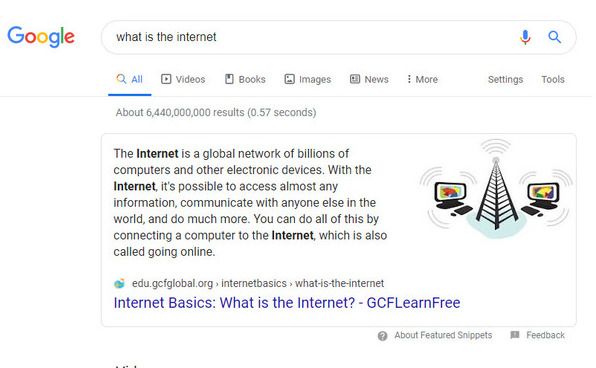Given that an estimated 53% of your website traffic arrives from organic search, it is important to keep track on what developments, like Knowledge Graph, can boost your organic traffic.
What are Google Quick Answers?
Google Quick Answers are highly-visible text snippet answers and links placed at the top of the Google SERPs. They're also referred to as Quick Answers boxes, Rich Answers, Rich Answer boxes, Featured Snippets, and Google Answers. They are observed to provide a huge boost in organic traffic. Quick Answers appear up to 40% of the time for some types of queries. Some of the most important things to know about Quick Answers are:
 Pages that have a Quick Answer box and ranked result perform better than those with just a high-ranking result
Pages that have a Quick Answer box and ranked result perform better than those with just a high-ranking result- Quick Answers click-through traffic generates increased revenue and conversions
- Quick Answers allow sites that haven't made it to the top of the SERP to receive a huge boost in traffic
How do I optimized for Quick Answers?
There are 4 key factors that Google looks at when choosing a page to show up in the Quick Answer box. They strongly correlate to a particular site being afforded a Quick Answer box. If you pay close attention to them, they'll help you boost your chances of having a snippet taken from your page. Here are the four factors to consider when you optimize for Quick Answers:
1. Be in the Top 5 on the SERP
An estimated 77 percent of the Quick Answer responses are taken from websites ranked within the top five. Although you might occasionally see results that break this rule, it is clear that if you want to increase the chances of getting your response highlighted in a box, you want to have a strong ranking on the SERP.
2. Have at least 1,000+ links to your domain
Referring domains are an excellent way to tell Google that your site is viewed as reputable and that people trust what you have to say. About 81 percent of the sites with a Quick Answer have a minimum of 1,000 referring domains. Fifty percent, however, have over 10,000. When it comes to cultivating these links, the more you have, the stronger your site will be.
3. Have less than 2,000 words on a page
Research has shown that most of the sites ranking in the top slots on Google are longer, within 1,500 words widely considered to be ideal for most topics. However, there appears to be a maximum as well - an estimated 70 percent of the sites with Quick Answers have less than 2,000 words.
4. Have good user engagement
Like the referring domains, user engagement tells Google that people like what you have to say and value your opinion. Sites with high bounce rates generally did not answer their visitors' needs and did not help with their query. A site that boasts strong engagement numbers, however, is likely well-regarded on the topic and will produce the quality answer that Google would want to display. Keeping these four factors in mind, you now need to choose the best opportunities to pursue. The main challenge here is picking the keywords for which you have a high chance of making it into Quick Answers. BrightEdge can be a valuable platform and can help brands identify the most viable opportunities. You must first identify where your best opportunities lie to receive a Google Quick Answer box. Focus your efforts on the topics that are most associated with your domain. In other words, focus on the queries and keywords you already rank high on or those related to them. By working on these opportunities, you are more likely to be rewarded with the box. On-page optimization to receive the Google Quick Answer Box includes the following seven techniques:
- Structure the page with the user experience in mind. Generally, this means keeping paragraphs short (350-500 characters) and using scannable lists when applicable. Headings can also be valuable to ensure that people can find the topics that interest them the most within the piece.
- Include your target question in the H1. This way you will make sure that Google understands your intention with a particular page.
- Provide a short, direct answer to your question in the first paragraph. If your question is best answered with a list, then include either ordered list (<ol>) or unordered list tags (<ul>). As you develop the rest of your copy, use variations of your keyword.
- Use 'how to' or other lists in your page as appropriate. If you use unordered lists, consider adding "Step one, Step two, etc.) to each of the bullets as you appropriate to make it easier for Google to interpret it.
- Include media content on the page: images, videos, infographics, and more. Make sure there media materials are consistent with your content and demonstrate the depth of your knowledge. Images are a must-have.
- Link to other related pages on your website. This will demonstrate to Google that you have the contextual breadth of knowledge needed to provide users with a trustworthy, high-value answer.
- Create 'related materials' and 'related guides' sections at the bottom of the page. To learn off-page optimization techniques for obtaining the Quick Answers box, download the full white paper.
This white paper features a step-by-step process from choosing the best opportunities to optimize for Quick Answers, shows how the BrightEdge platform helps you gain Quick Answer boxes, and track success. It finishes by outlining 20+ optimize for Quick Answers best practices that maximize your chances of boosting organic traffic to your website. Get started optimizing your content today.


